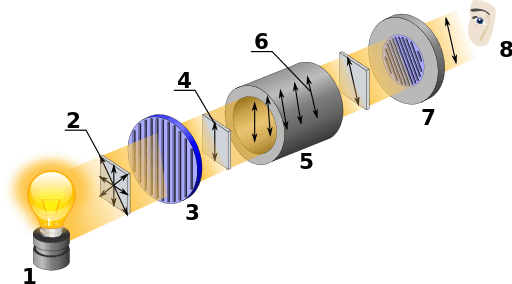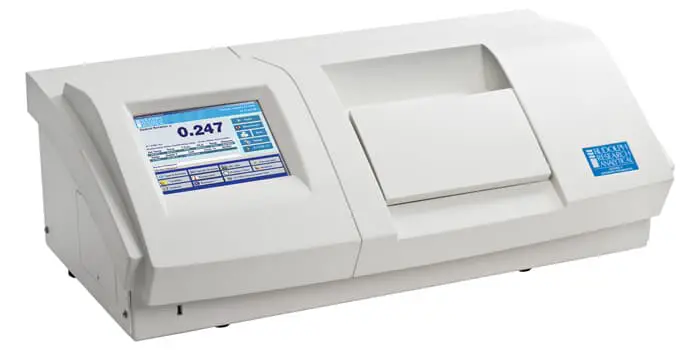Polarimetric methods are reliable and simple methods for determining and analyzing the structure of expensive and nonreplicable samples in macro, semi-micro, and microanalysis.
Pharmaceutical, chemical, essential oil, flavor, and food industries use polarimetry for quality control, process control, and research. This technique is so well established that major pharmaceutical companies, as well as the Food & Drug Administration (FDA), use it to describe many substances.
This blog will cover most of the interview questions on polarimeter.
Interview Questions on Polarimeter:

Q1: What is the USP general chapter number for Polarimeter?
A: USP <781> Optical Rotation.
Q2: What is the Definition of a Polarimeter?
A: A device for measuring the polarization of light, and especially (in chemical analysis) for determining the effect of a substance on rotating the plane of polarization of light. Or Especially when used with liquids, the polariscope measures the amount of rotation of the plane of polarization.
Q3: What is the principle of a Polarimeter?
A: A polarimeter measures the rotation of polarized light as it passes through an optically active fluid. Calculating the value of solution concentrations can be done using the measured rotations, especially when dealing with sugars, peptides, and volatile oils.
Q4: What is the function of the polarimeter?
A: Polarimeters measure the direction of polarisation of light or the rotation of a substance to determine its optical properties.
Q5: Which light source is used in polarimetry?
A: A Sodium lamp is used as a light source in a polarimeter.
Q6: Why is a sodium lamp used in a polarimeter?
A: Due to its monochromatic light and high energy output, sodium light is used for this application.
Q7: How does a polarimeter work?
A: Using a polarimeter, you can determine if a sample contains one or both enantiomers. This instrument includes a light source, polarizer, sample cell, detector, and analyzer.
Q8: What is the purpose of a polarimeter?
A: Polarimeters are devices that measure the polarisation direction of light or the rotation of an optically active substance.
Q9: What is polarimeter instrumentation?
A: A polarimeter consists of;
- light source,
- A monochromator, (filters out all but a specific wavelength of light)
- A polarizer (converts the light beam to plane-polarized light),
- A sample tube (holds the sample being measured),
- A second polarizer (to determine the degree of rotation), and
- A light detector.
Q10: What is D line of Sodium?
A: On the Sodium spectrum, the D-lines are the prominent lines at 588.9950 and 589.5924 nanometers, known as the Sodium D-lines. It can be seen from the energy level diagram that these lines are emitted during a transition from the 3p to the 3s levels. There is twice the intensity of the line at 589.0 nm compared to the line at 589.6 nm.
Q11: Why are some molecules optically active?
A: An enantiomer of a chiral molecule rotates light in a certain direction when plane-polarized light passes through one of the two enantiomers. When the same plane-polarized light is passed through the other enantiomer, that enantiomer rotates light in the opposite direction by the same amount.
The light will rotate counterclockwise for one enantiomer and clockwise for the other. Because chiral molecules can rotate the plane of polarization differently as a result of interacting with an electric field differently, they are known as optically active molecules.
Q12: What are Enantiomers?
A: The Chiral molecule has two mirror images that cannot match perfectly-the mirror images are non-superimposable. The mirror images of a compound are called enantiomers.
Q13: Is glucose optically active?
A: Yes, Due to the chiral centers of four carbon atoms within glucose make it an optically active compound.
Q14: What is a formula for SOR?
A: The formula for SOR is,
OR/(Conc. of Sample x Path length)
αobserved
[α] = —————-
c x l
where, α = Specific Optical Rotation,
αobserved = Optical Rotation,
c = Concentration of sample,
l = Path Length
Q15: What is the length of the polarimeter tube?
A: There is no specific length, it varies from 5 mm to 200mm.
Q16: How do you find the concentration of a polarimeter?
A: Let’s see an example to understand this answer,
For example, if a sample prepared by dissolving 2 g of optical material in water to a final volume of 20 mL and measuring its optical rotation in a 5.0 cm cell was determined to have an optical rotation of +5.5 degrees, then the concentration of the sample 2 g/20 mL = 0.2 g/ml, and, [α] = 5.5/(0.2×5) = 5.5.
Q17: Why sucrose is used for the calibration of the polarimeter?
A: Basically, polarimetry analyzes the angle of rotation of transverse waves (e.g., electromagnetic light), which passes through optically active fluids like sucrose, which is nearly ideal for testing and calibration.
Q18: In calibrating polarimeters, why should sucrose solutions of 10%,20%,30% be used?
A: When we use above 30% concentration, assume we use 40% concentration or more. In such a case, two molecules will be arranged one behind the other, and you will have a minimum optical rotation with respect to actual concentration.
Q19: What is the wavelength of the polarimetry lamp?
A: 589.44nm, Sodium lamp polarimeter.
Q20: What is the value of specific rotation of sugar solution?
A: The value of the specific rotation solution is 0.
Q21: How do you fill a polarimetry tube?
A: A slight incline should be achieved with the tube.
Q22: Which waves can not be polarized?
A: As long as the motion of particles is in one dimension, longitudinal waves cannot be polarized, such as sound waves. Therefore, ultrasonic waves cannot be polarized since they are sound waves.
Q23: What is the use of specific rotation?
A: When producing pharmaceuticals and cosmetics, for instance, specific rotation of products can be a key parameter to control the purity of the optical active ingredients.
Q24: What is the angle of rotation in the polarimeter?
A: An optically active substance is passed through polarized light to measure the angle of rotation. Polarimeters measure this angle.
Q25: What is the advantage of sodium D line light to be used in the polarimeter instead of normal light?
A: Na (Sodium) Lamps produce monochromatic, high-energy light, making them ideal for polarimetry. High sensitivity and signal-to-noise ratio. Monochromatic light is produced by a line spectrum, i.e. at 589nm.
Q26: What is the difference between optically active and inactive?
A: If light moves to the right, then the optical activity is dextrorotatory, and if it moves to the left, then the optical activity is levorotatory. Similarly, if the light stream passes through the Nicol prism, the light is unaffected. As a result, it has been described as optically inactive.
Q27: Why is the plane of polarized light rotated by optically active compounds?
A: An optically active substance has a chiral c – atom. It contains different molecules (group of atoms) attached to it, which will prevent the light from passing through it when it falls on a larger molecule (may be on the left or right side). Like an optical substance, it rotates its path.
Q28: What are dextrorotatory and levorotatory?
A: Compounds that rotate plane-polarized light clockwise (+) are described as dextrorotatory, while those that rotate clockwise (-) are described as levorotatory.
Q29: Which solution is traditionally used for the calibration of polarimeter?
A: The traditional method used to calibrate polarimeters used sugar solutions of a defined concentration with polarimeters relating sugar molecules to light rotation.
Q30: What is the calibration slope?
A: The calibration slope is a conversion factor used by the pH meter to convert electrode signals from mV to pH. The pH meter determines the slope by measuring the difference between two buffers’ mV readings and dividing by the difference in pH.
Q31: Applications of polarimetry in the Pharmaceutical industry?
A: By measuring specific rotation and optical rotation, polarimetry determines product purity:
- Cocaine
- Diuretics
- Codeine
- Serums
- Vitamins
- Tranquilizers
- Amino Acid
- Steroids
- Dextrose
- Antibiotics
- Amino Sugars
- Analgesics
Q32: What is the difference between OR and SOR?
A: The purpose of optical rotation and specific rotation is the same: rotating plane-polarized light into different directions by means of certain substances. They are called optical isomers or enantiomers.
An optical rotation happens when light beams are directed through certain materials and plane-polarized light rotates.
A specific rotation describes the angle of rotation of plane-polarized light by a certain compound at a specific temperature.
Standard rotation measurements for optical rotation for specific chemical compounds are known as specific rotations.

Image Source: Rudolphresearch.com
I hope you found the all types of interview questions on polarimeter. This article may help you to answer the interview.
Also read:
- HPLC Interview Question and Answers
- Gas Chromatography Interview questions and answers
- Karl Fischer Titration Interview Question and Answer
- Dissolution Interview Question and Answer
- What is Annual Product Quality Review (APQR)?
- What Is Change Control In pharma?
- CAPA Process in Pharmaceutical Management System
- FAQ’s On FDA’s Data Integrity
YT channel: Pharmabeejpro